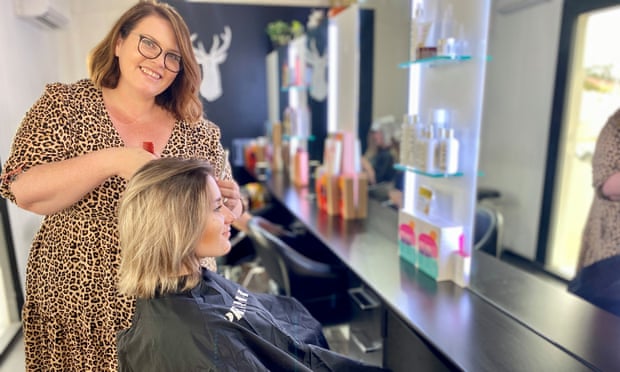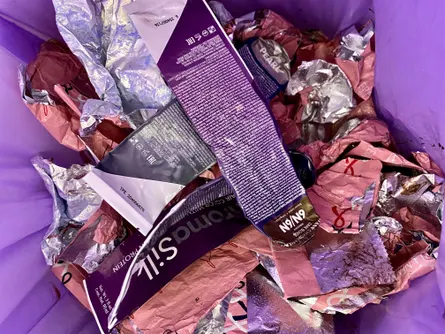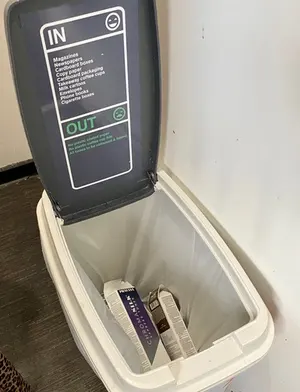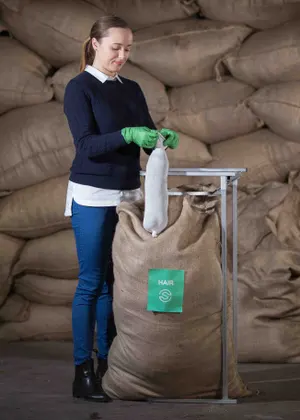Cutting waste: how a salon recycles 65 bags of hair

Australia’s hairdressers are getting serious about recycling, using clippings for compost, turning bottles into eyewear, and keeping bleach out of the drain
I’m at the salon and the hairdresser is talking rubbish. To be precise, she’s telling me exactly how much waste her salon recycles: last year it was 1.25 tonnes, the weight of a Volkswagen Golf.
Kristi Lauren has signed up to one of Australia’s two salon-specific recycling programs, where everything from hair to bleach to shampoo bottles are diverted from landfill and recycled in innovative ways. Last year she sent off 65 rubbish bags of hair, 115 of metal, 149 of plastic and 117 of paper and cardboard.

Lauren signed up after her bins got so full she had to send staff home with bags of rubbish. Her eight-chair salon, Pout Hair, in the Brisbane suburb of Greenslopes, is connected to her house, and council wouldn’t give her commercial bins: “Living at the back of here with twins and all their nappies, and only having the normal bins we just couldn’t keep up with the waste.”
Lauren now has her waste collected by Waste Free Systems, a social enterprise set up by organic hairdressing veteran Bernie Craven to reduce the mountains of waste created by his industry.

Lauren explains the extent of the problem: “Everything we do creates waste. Our colour tubes are boxed, and they can have a paper ingredient list and instructions as well as the plastic lid and the metal tube. All our product bottles … all our peroxide bottles … all our foil.” Then there’s all that cut hair, and the excess colour and bleach that would normally be washed down the sink.
Craven says the system is designed to work in busy salons, with a bin system and a wall chart: “If we can separate it before it leaves the business, you can recycle so much more,” he says. He charges a fee for collecting the waste, and money raised by selling recycled materials goes to charities such as Foodbank and Bravehearts. Lauren says it’s a small price to pay: “It ends up being about $2 per client – we call it a green tax.”
Recycling can also cut salon expenses, as it highlights product waste. Lauren explains: “Once upon a time if you mixed up too much colour it literally went down the sink.” Recycling “makes us use less product … because we see it in the bucket.”
Paul Frasca is the co-founder of Sustainable Salons, a similar service which now works with almost 1,000 hairdressing salons, barbers, beauty salons, dermal clinics and even pet-grooming salons across Australia and New Zealand.
Frasca says many salons now actively market their green credentials: “The conscious consumer is now the most important customer on the market … So it makes business sense, not just environmental sense.”
But where does the waste go next?

Some of the recycling is straightforward: paper, cardboard, metal and glass are sorted and sent to Australian recyclers. Frasca says chemicals such as bleach and hair colour are collected, stored in bulk tanks and then neutralised – and they coach hairdressers on how to squeeze as much colour as possible off their clients’ hair to be stored and treated “before it goes down the drain.”
Both programs are also researching new ways to redirect waste. Craven is adding hair to compost (hair is full of silica and returns nitrogen to the soil), while Frasca makes hair booms for cleaning up oil spills. Sustainable Salons even collects ponytail-length hair to donate to charities, so it can be made into wigs for people who have lost hair after cancer treatment or due to the auto-immune disorder alopecia areata.
Sustainable Salons has partnered with Dresden Vision to turn plastic shampoo bottles into spectacle frames, while Waste Free Systems has experimented with turning plastic bottles into 3D printing filament. Craven has printed prototype prosthetics for two Sunshine Coast teens, who were both born with only one hand: “Both the kids we worked with were very good at sport. They had no funding before, but we could give them a hand.”
Craven says plastic can only be melted and recycled a limited number of times, spurring him to find novel ways to turn it into products that stay out of the waste stream for longer: “It’s such a big problem worldwide. I’m determined to find a solution to it.”
Source: The Gaurdian
